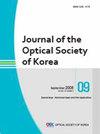Role of Arbitrary Intensity Profile Laser Beam in Trapping of RBC for Phase-imaging
Q Physics and Astronomy
引用次数: 4
Abstract
Red blood cells (RBCs) are customarily adhered to a bio-functionalised substrate to make them stationary in interferometric phase-imaging modalities. This can make them susceptible to receive alterations in innate morphology due to their own weight. Optical tweezers (OTs) often driven by Gaussian profile of a laser beam is an alternative modality to overcome contact-induced perturbation but at the same time a steeply focused laser beam might cause photo-damage. In order to address both the photo-damage and substrate adherence induced perturbations, we were motivated to stabilize the RBC in OTs by utilizing a laser beam of ‘arbitrary intensity profile’ generated by a source having cavity imperfections per se. Thus the immobilized RBC was investigated for phase-imaging with sinusoidal interferograms generated by a compact and robust Michelson interferometer which was designed from a cubic beam splitter having one surface coated with reflective material and another adjacent coplanar surface aligned against a mirror. Reflected interferograms from bilayers membrane of a trapped RBC were recorded and analyzed. Our phase-imaging set-up is limited to work in reflection configuration only because of the availability of an upright microscope. Due to RBC’s membrane being poorly reflective for visible wavelengths, quantitative information in the signal is weak and therefore, the quality of experimental results is limited in comparison to results obtained in transmission mode by various holographic techniques reported elsewhere.任意强度轮廓激光束在相位成像中捕获红细胞中的作用
红血球(红细胞)通常粘附在生物功能化的底物上,使其在干涉相位成像模式中固定。这可以使他们容易受到先天形态的改变,由于他们自己的体重。光镊通常由激光束的高斯分布驱动,是克服接触引起的微扰的一种替代方式,但与此同时,激光束的急剧聚焦可能会造成光损伤。为了解决光损伤和衬底附着引起的扰动,我们利用具有腔体缺陷的光源产生的“任意强度分布”激光束来稳定OTs中的RBC。因此,研究了固定化红细胞与正弦干涉图的相位成像,该干涉图由紧凑而坚固的迈克尔逊干涉仪产生,该干涉仪由一个立方体分束器设计,其中一个表面涂有反射材料,另一个相邻的共面与镜子对齐。记录并分析了捕获红细胞双层膜的反射干涉图。由于立式显微镜的可用性,我们的相位成像装置仅限于在反射配置下工作。由于RBC膜对可见波长的反射较差,信号中的定量信息较弱,因此,与其他地方报道的各种全息技术在传输模式下获得的结果相比,实验结果的质量受到限制。
本文章由计算机程序翻译,如有差异,请以英文原文为准。
求助全文
约1分钟内获得全文
求助全文

 求助内容:
求助内容: 应助结果提醒方式:
应助结果提醒方式:


